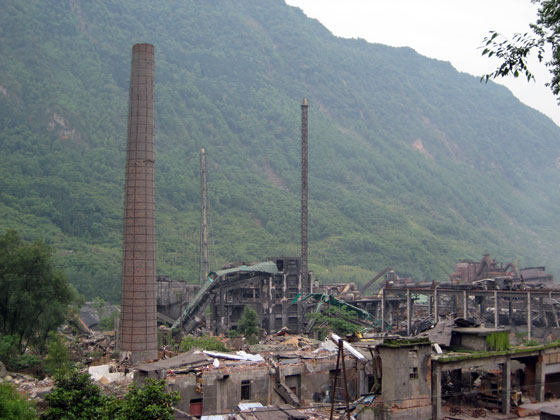Study shows dramatic increases in China’s economic exposure to earthquakes
24 Feb 2017 by Simon Davies An industrial complex in the aftermath of the 2008 Sichuan earthquake. Photo: Seoul Metropolitan Fire and Disaster Headquarters.
An industrial complex in the aftermath of the 2008 Sichuan earthquake. Photo: Seoul Metropolitan Fire and Disaster Headquarters.
China’s economic exposure to earthquakes has dramatically increased since 1990, researchers from Beijing Normal University have found.
They found that rapid economic growth and urbanisation in the country have led to huge spatiotemporal changes in the economic value of the country’s assets (buildings and non-building infrastructure) and gross domestic product (GDP) exposed to seismic hazards.
Their results, published today in the journal Environmental Research Letters, were obtained using gridded maps of GDP and asset value, overlaid with the latest seismic maps to investigate spatiotemporal changes in economic exposure in the most seismically hazardous areas (MSHAs) in China in 1990, 2000 and 2010.
Lead author Dr Jidong Wu, from Beijing Normal University’s Academy of Disaster Reduction and Emergency Management, said: “The 2008 Wenchuan earthquake resulted in US$124 billion in direct losses and around 80,000 deaths. The Tangshan earthquake in 1976 resulted in around US$10 billion in direct losses, and over 242,000 deaths, and the post-disaster economic recovery took at least 11 years”.
“Earthquakes, then, are one of the most serious natural disaster threats in China, so timely and accurate assessment of GDP and asset value exposure to earthquakes is essential for loss estimation and risk assessment.”
The team found that, by 2010, 15.4% of China’s asset value and 14.1% of its GDP were located in MSHAs. The asset value and GDP exposed to MSHAs had reached 15.9 trillion CNY and 6.2 trillion CNY respectively, rising from 1.83 trillion CNY and 730 billion CNY in 1990 – indicating average annual increases of 14.4% for asset value, and 11.3% for GDP since 1990.
The most notable economic exposure increases were located in three seismic belts: the North, Northeast and Tianshan seismic belts. In these areas, both the GDP and asset value growth rates were higher than the overall rates in MSHAs.
The North seismic belt, which includes Beijing, has the largest economic exposure in a seismic belt, as 73.2% of the MSHA GDP, and 70.7% of the MSHA asset value were located in this area in 2010. The Qinghai-Tibet seismic belt, meanwhile, accounted for 17.1% of the MSHA GDP and 19.6% of the MSHA asset value in 2010.
Dr Wu said: “History shows the vulnerability of asset values to earthquakes in China. Assuming the current rates of urbanization and economic growth in China continue, both the percentages of GDP and asset value exposed to seismic risk in MSHAs will continue to grow, especially in the North seismic belt and the Qinghai-Tibet seismic belt. The former currently has the highest economic exposure, while the latter exhibited the highest seismic frequency over the last 55 years. Meanwhile, devastating earthquakes with Ms values of 8.0 have occurred in these seismic belts.
“The Chinese government should pay more attention to the economic exposure changes in MSHAs, especially in the two seismic belts mentioned here.”